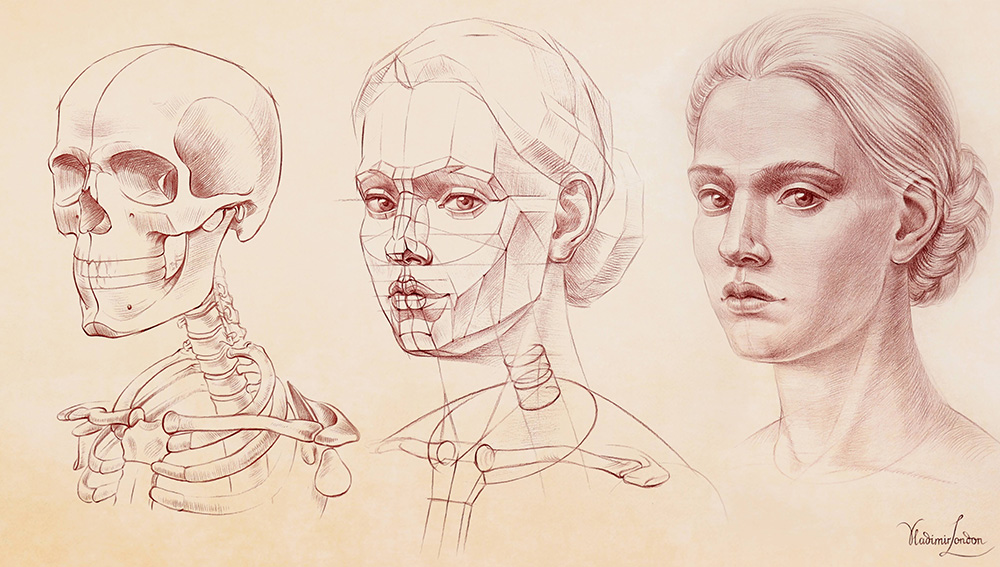Have you ever wondered why children can draw and why we lose this ability with age? Drawing is a non-verbal language, a way of thinking, and a means of turning thoughts into pictures. Every child has an innate talent for drawing; they do it intuitively. The quality of drawing does not cross a young artist’s mind until it is pointed out by peers or adults, or until a teacher gives low marks that undermine the natural talent. This leads to a life-shaping decision: whether to continue drawing, regardless of others’ opinions, or to put in minimal effort to complete school tasks and never return to art. Those with a natural inclination for drawing would continue to sketch and doodle whatever comes to mind. Skills will improve little by little, and after about ten thousand hours of practice, others will start saying, “He is so talented.” But is it a talent or the result of hours of hard work? One of the greatest artists to have ever lived, Michelangelo Buonarroti, once said, “If people knew how hard I worked to get my mastery, it wouldn’t seem so wonderful at all.” Telling an artist, “You are so talented,” is one of the biggest insults that undermines all their efforts. It is like telling an Olympic champion, “What a wonderful talent you have to run so fast,” when such an athlete has trained for several hours every single day for the last ten years to earn a gold medal. Of course, such an athlete would most certainly have a natural inclination for running; otherwise, one would not have such a dedication to training. This brings us to the conclusion that every able child can run, but only a few would continue training for ten thousand hours to become professional athletes. Drawing is a skill, and as such, it is no different from running. To be good at drawing, you have to learn and practice; no “talent” would replace such efforts.
Watch this video to self-assess your drawing skills:
When it comes to drawing, the “life-changing” decision is not about choosing an art career. Because drawing is a non-verbal language of communication, such a skill will be helpful in whatever career you choose. Every profession you can think of would undoubtedly benefit from the ability to draw; from a teacher to a truck driver, having good visual communication skills will give you an edge in being better at what you do. Even if you never draw a picture at your workplace, the way you think would be different. You can think faster with images than words; one picture can replace a thousand words.
So, if the necessity of having a developed visual language is obvious, and an absence of some “inborn talent” is not an obstacle, what other circumstances may prevent you from learning drawing? There might be no art schools in your location, no art teachers, no art supply stores, no free time, no money for education, or you might think you are too old to learn new things. Let’s see if those things really matter.
The Internet changed the Globe into a “local village”. As long as you have internet access, the necessary information can be displayed on your screen with the click of a button. You do not have to live next to an art college to attend it. In the same way, art teachers will be available should you decide to learn new skills. When it comes to art supplies, do not confuse skills with tools. The ability to draw does not rely on tools; whether you draw with a pencil on paper or with a finger on a dusty window, the rules of trade will be the same. Perspective, anatomy for artists, elements of composition, constructive drawing principles, and so on will be the same regardless of what drawing tools you use. If you have a piece of paper and a pen or pencil, that’s all you need to start learning. The lack of time is another big excuse. A quick portrait sketch can be done in under two minutes; doodling five portraits would take only 10 minutes. Everyone can find 10 minutes a day, no matter how busy their life is. Drawing five portraits a day is a great exercise to keep polishing your skills. How many portraits have you done this week, this year? When it comes to your age, there is no such thing as being too old to learn drawing. Tomorrow, you will be one day older, so the right time to start is today. Now, the biggest obstacle of all – lack of money. There are endless free drawing tutorials available on YouTube; the question of money is not applicable here. However, the quality of such tutorials is questionable. There are many “watch me drawing” videos by amateur enthusiasts among the outstanding lessons. If you do not recognize what is good and what is not, you might pick up bad drawing habits from such videos. If you practice those habits for a long time, you will become very good at making the same mistakes repeatedly; relearning good skills will be much harder. Additionally, copying images displayed on a flat screen poses another danger – falling into the trap of copying. Copying and drawing require two very different sets of skills. One will suppress another. The more you copy, the less you will be able to draw from life and imagination.
This raises a question: Is it possible to learn to draw by watching video tutorials? If you are serious about getting advanced drawing skills, you need a professional art teacher who is also a talented artist. The entire history of fine arts does not know a single great artist who was entirely self-taught. Drawing is a part of culture, and culture is passed from one person to another. Without such a teacher-to-student relationship, every new generation would start from the pre-stone age. That is why drawing video lessons are only good when you also receive personal tutoring from a teacher who can assess your level of drawing skills, understands your goals, use a well-structured drawing curriculum, provide step-by-step instructions and demonstrations, critique every artwork you make, point out the mistakes you make, advise how to fix them, and check your performance on the ongoing basis for as long as you need it. Even at the best contemporary art colleges, you wouldn’t find such service. These days, art colleges employ teachers who are not professional artists. A career in art and a career in teaching are separated now. Because you could not expect excellent tutoring from teachers who do not possess the skills of the trade, the educational process is refocused from practical skills to creativity.
However, there is one drawing course available that addresses this challenge. It is called the Life Drawing Academy Correspondence Course, and it is led by talented artists who are also professional art teachers with extensive experience.
Find out what makes this drawing course one of the best in the World:
What makes this course unique is that it follows the traditional foundations of classical art education, based on the principles of constructive drawing. There are 34 constructive drawing principles, which are no longer taught at contemporary art colleges. For example, one of these principles describes 16 different types of linear perspective, which are covered in depth at the Life Drawing Academy, whereas art colleges hardly mention more than two. There are many other principles, rules, drawing methods, and techniques that are unique to the Life Drawing Academy Correspondence Course, including 21 rules of drawing in perspective, 15 elements of composition, 100 drawing techniques, 51 portrait-drawing rules, special methods of drawing flat shapes and three-dimensional objects, to name a few.
This wealth of information and know-how comes in 52 multi-part video lessons and hundreds of dedicated tutorials and demos that are thoroughly structured into a robust and comprehensive curriculum, which covers all the drawing topics a fine artist must know, from very simple tasks on how to sharpen and handle a pencil to how to draw portraits and figures. A student in this course is not left alone to wander through all those lessons. The one-to-one personal tutoring is provided by correspondence. Upon enrollment, a student is assigned a dedicated art teacher and receives a Welcome email with instructions on art materials and a list of test drawings that need to be completed before receiving the first drawing task. The academy tutors review test artworks and provide thorough feedback on the student’s current level of drawing skills, pointing out areas for improvement. They then create a custom-designed drawing curriculum tailored to the student’s level of skills and needs. Such a curriculum takes into account the interests of every particular student, so the education would fit not only their needs, but also their goals and inspirations. That is why this course is perfectly suitable for complete beginners and advanced artists. Everyone would receive a personalized curriculum that fills the gaps in art education and focuses on topics a student wants to learn, such as portrait drawing, character design, illustration, landscape, or animalistic drawing, among others.
The difference between the Life Drawing Academy Correspondence Course and contemporary art colleges is so significant that they seem to be worlds apart. Contemporary art colleges do not typically provide unlimited personal tutoring, unlike the individualized art curriculum for which the Correspondence Course is known. There are 100 drawing tasks in that course. Every task presents something new to learn and practice, preparing a student for the next assignment. The skills one learns at the beginning are vital for understanding the subsequent topics correctly. For example, at art colleges, students are not taught how to hold a pencil; however, the Correspondence Course begins with this basic yet very important skill. It takes time to develop the correct pencil grip and achieve the level of mastery when a pencil no longer feels like a tool in a hand, but becomes a continuation of a mind. There are special exercises students do to develop this skill. The tasks on drawing flat shapes prepare students to advance to three-dimensional drawing. Students learn special methods of measuring relative proportions and angles, checking alignments, levels, and cross-points, which prepare them for drawing from life. By drawing simple geometric bodies, students prepare for more complex topics, such as drawing from life and imagination, encompassing whatever they see or imagine. They study classical architectural canons to develop a better appreciation for art and gain an understanding of the ancient heritage that continues to this day.
The main approach in this course is based not on copying what you see, but drawing what you know about objects you see. This requires a good understanding of perspective and foreshortening, as well as knowledge of contours and intersections. By the way, the topics of contours and rules of intersection are not taught at contemporary art colleges at all; however, without that knowledge, an artist would have difficulties making objects in drawing appear three-dimensional. This influences the next important aspect of drawing, tonal rendering. Art colleges do not teach the main purpose of rendering, which is not to decorate objects with values of chiaroscuro, light, and shadow, but to reveal a three-dimensional construction by means of shading, hatching, and cross-hatching along the object’s 3D shape, which is constructed with the help of virtual contours. Such contours are imaginary helping lines that are obtained by intersection with virtual planes. When the knowledge of intersection is missing, the understanding of contours is also missing. When the main purpose of tonal rendering is misunderstood, there is no hope of learning proper rendering techniques fast. That is why, at the Life Drawing Academy, students receive special tasks on the theory of contours and intersections, and study 25 tonal rendering rules together with the right techniques of hatching and cross-hatching. Could you learn this on your own? Probably not. This is not because this theory is complex, but because there are contours that “pop” the 3D shape and those that flatten it. This difference is not intuitive, and you need an art teacher who will point out your mistakes and explain how to fix them. The know-how of constructing and rendering objects prepares a student for making more complex artworks – compositions. The standard theory of composition consists of only eight elements, which is not enough to use its rules fully. At the Life Drawing Academy, not eight, but fifteen elements are explained and demonstrated in depth, and students complete special tasks to learn the principles of composition fully.
The drawing curriculum progresses from basic to more advanced topics, including anatomy for artists, construction, and proportions of the human body, head, and face. In this course, students discover not one, but three classical canons of human body proportions. Such a variety is not taught anywhere else. In addition to drawing tasks, students also make models and sculptures to understand construction and anatomy. During this course, students create 25 DIY models, including a life-size skull, head, shoulder girdle, hand, and facial features. Every model-making and sculpting task comes with special templates that are unique to this course and not available anywhere else. With such templates, you can make a perfect model of a head or eyes, even if you have never sculpted before. A big portion of this course is dedicated to portrait and figure drawing. With numerous tasks ranging from simple to more advanced, students learn how to draw realistic paintings with a full understanding of anatomy and proportions from any point of view. They also learn how to depict emotions in portraits and create figurative compositions that tell a story and evoke emotions.
The step-by-step tutoring gradually and logically brings a student from basic to advanced levels of drawing skills. And the best thing is – there is no way to fail. Every topic is explained in depth, complete with written instructions, visual examples, and video lessons that help resolve any challenge with ease. When needed, the academy tutors will make a video just for you to explain any topic you have difficulty with. No art teacher at any contemporary art college would ever make a video for an individual student. In the Correspondence Course, you will know what to do and how at every step, and your tutor will give you constructive criticism on every artwork you make in this course. Studying by correspondence gives another edge. Every task, instruction, critique, explanation, and feedback will be in writing, so you can refer to what was said and advised at any time in the future. Every subsequent task will be assigned when you complete the previous one to the required standard. That is why you are guaranteed to reach the advanced level of drawing skills should you continue to the end of this course.
When it comes to the tuition fee, this course is not free, but it is heavily subsidized, so you pay a significantly reduced amount compared to the actual cost. And the best part is – you will get a lifetime membership for a one-time fee and can study in the comfort of your home for as long as it takes for you to get advanced drawing abilities.
To find out more, watch free drawing tutorials from the Life Drawing Academy course.






